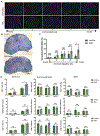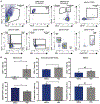Regulatory T cells promote remyelination in the murine experimental autoimmune encephalomyelitis model of multiple sclerosis following human neural stem cell transplant
- PMID: 32276110
- PMCID: PMC7253332
- DOI: 10.1016/j.nbd.2020.104868
Regulatory T cells promote remyelination in the murine experimental autoimmune encephalomyelitis model of multiple sclerosis following human neural stem cell transplant
Abstract
Multiple sclerosis (MS) is a chronic, inflammatory autoimmune disease that affects the central nervous system (CNS) for which there is no cure. In MS, encephalitogenic T cells infiltrate the CNS causing demyelination and neuroinflammation; however, little is known about the role of regulatory T cells (Tregs) in CNS tissue repair. Transplantation of neural stem and progenitor cells (NSCs and NPCs) is a promising therapeutic strategy to promote repair through cell replacement, although recent findings suggest transplanted NSCs also instruct endogenous repair mechanisms. We have recently described that dampened neuroinflammation and increased remyelination is correlated with emergence of Tregs following human NPC transplantation in a murine viral model of immune-mediated demyelination. In the current study we utilized the prototypic murine autoimmune model of demyelination experimental autoimmune encephalomyelitis (EAE) to test the efficacy of hNSC transplantation. Eight-week-old, male EAE mice receiving an intraspinal transplant of hNSCs during the chronic phase of disease displayed remyelination, dampened neuroinflammation, and an increase in CNS CD4+CD25+FoxP3+ regulatory T cells (Tregs). Importantly, ablation of Tregs abrogated histopathological improvement. Tregs are essential for maintenance of T cell homeostasis and prevention of autoimmunity, and an emerging role for Tregs in maintenance of tissue homeostasis through interactions with stem and progenitor cells has recently been suggested. The data presented here provide direct evidence for collaboration between CNS Tregs and hNSCs promoting remyelination.
Keywords: Multiple sclerosis; Neural stem cells; Neuroinflammation; Regulatory T cells; Remyelination.
Copyright © 2020 The Authors. Published by Elsevier Inc. All rights reserved.
Conflict of interest statement
Declaration of Competing Interest The authors have no competing interests to disclose.
Figures







Similar articles
-
Remyelination Is Correlated with Regulatory T Cell Induction Following Human Embryoid Body-Derived Neural Precursor Cell Transplantation in a Viral Model of Multiple Sclerosis.PLoS One. 2016 Jun 16;11(6):e0157620. doi: 10.1371/journal.pone.0157620. eCollection 2016. PLoS One. 2016. PMID: 27310015 Free PMC article.
-
Neural stem cells derived from primitive mesenchymal stem cells reversed disease symptoms and promoted neurogenesis in an experimental autoimmune encephalomyelitis mouse model of multiple sclerosis.Stem Cell Res Ther. 2021 Sep 9;12(1):499. doi: 10.1186/s13287-021-02563-8. Stem Cell Res Ther. 2021. PMID: 34503569 Free PMC article.
-
Continuous Immune-Modulatory Effects of Human Olig2+ Precursor Cells Attenuating a Chronic-Active Model of Multiple Sclerosis.Mol Neurobiol. 2020 Feb;57(2):1021-1034. doi: 10.1007/s12035-019-01802-7. Epub 2019 Oct 28. Mol Neurobiol. 2020. PMID: 31656989
-
Promoting remyelination through cell transplantation therapies in a model of viral-induced neurodegenerative disease.Dev Dyn. 2019 Jan;248(1):43-52. doi: 10.1002/dvdy.24658. Epub 2018 Sep 6. Dev Dyn. 2019. PMID: 30067309 Free PMC article. Review.
-
Neural Stem Cell-Based Regenerative Approaches for the Treatment of Multiple Sclerosis.Mol Neurobiol. 2018 Apr;55(4):3152-3171. doi: 10.1007/s12035-017-0566-7. Epub 2017 May 2. Mol Neurobiol. 2018. PMID: 28466274 Free PMC article. Review.
Cited by
-
Potential of Nano-Engineered Stem Cells in the Treatment of Multiple Sclerosis: A Comprehensive Review.Cell Mol Neurobiol. 2023 Dec 17;44(1):6. doi: 10.1007/s10571-023-01434-5. Cell Mol Neurobiol. 2023. PMID: 38104307 Free PMC article. Review.
-
The Integration of Cell Therapy and Biomaterials as Treatment Strategies for Remyelination.Life (Basel). 2022 Mar 24;12(4):474. doi: 10.3390/life12040474. Life (Basel). 2022. PMID: 35454965 Free PMC article. Review.
-
Presentation of Human Neural Stem Cell Antigens Drives Regulatory T Cell Induction.J Immunol. 2023 Jun 1;210(11):1677-1686. doi: 10.4049/jimmunol.2200798. J Immunol. 2023. PMID: 37083696 Free PMC article.
-
Inflammation in multiple sclerosis: consequences for remyelination and disease progression.Nat Rev Neurol. 2023 May;19(5):305-320. doi: 10.1038/s41582-023-00801-6. Epub 2023 Apr 14. Nat Rev Neurol. 2023. PMID: 37059811 Review.
-
Brain regulatory T cells.Nat Rev Immunol. 2024 May;24(5):326-337. doi: 10.1038/s41577-023-00960-z. Epub 2023 Dec 1. Nat Rev Immunol. 2024. PMID: 38040953 Review.
References
-
- Ben-Hur T, et al., 2013. Cell-based reparative therapies for multiple sclerosis. Curr Neurol Neurosci Rep. 13, 397. - PubMed
Publication types
MeSH terms
Grants and funding
LinkOut - more resources
Full Text Sources
Medical
Research Materials

